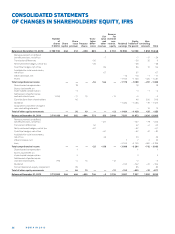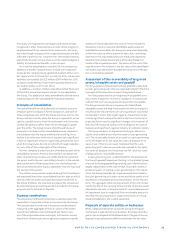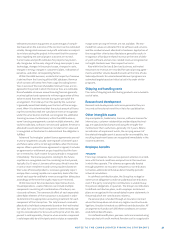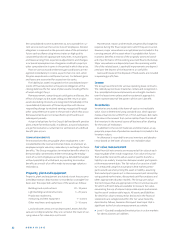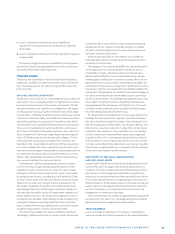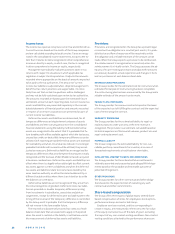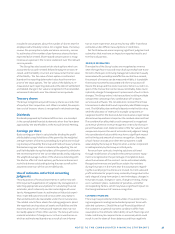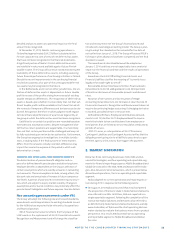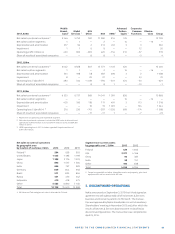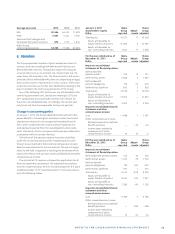Nokia 2013 Annual Report Download - page 35
Download and view the complete annual report
Please find page 35 of the 2013 Nokia annual report below. You can navigate through the pages in the report by either clicking on the pages listed below, or by using the keyword search tool below to find specific information within the annual report.33
NOTES TO THE CONSOLIDATED FINANCIAL STATEMENTS
■ Level – Valuation techniques for which signifi cant
inputs other than quoted prices are directly or indirectly
observable
■ Level – Valuation techniques for which signifi cant inputs are
unobservable
The Group categorizes assets and liabilities that are meas-
ured at fair value to the appropriate level of fair value hierar-
chy at the end of each reporting period.
Financial assets
The Group has classifi ed its fi nancial assets to the following
categories: available-for-sale investments, loans and receiva-
bles, fi nancial assets at fair value through profi t or loss and
bank and cash.
AVAILABLE-FOR-SALE INVESTMENTS
The Group invests a portion of cash needed to cover projected
cash needs of its on-going operations in highly liquid, interest-
bearing investments and certain equity instruments. The fol-
lowing investments are classifi ed as available-for-sale based
on the purpose for acquiring the investments as well as ongo-
ing intentions: () Highly liquid fi xed income and money-market
investments that are readily convertible to known amounts of
cash with maturities at acquisition of months or less, which
are classifi ed in the consolidated statements of fi nancial posi-
tion as current available-for-sale investments, cash equiva-
lents. Due to the high credit quality and short-term nature of
these investments, there is an insignifi cant risk of changes in
value. () Similar types of investments as in category (), but
with maturities at acquisition of longer than months, are
classifi ed in the consolidated statements of fi nancial position
as current available-for-sale investments, liquid assets. () In-
vestments in technology related publicly quoted equity shares,
or unlisted private equity shares and unlisted funds, are clas-
sifi ed in the consolidated statements of fi nancial position as
non-current available-for-sale investments.
Investments in publicly quoted equity shares are meas-
ured at fair value using exchange quoted bid prices. Other
available-for-sale investments carried at fair value include
holdings in unlisted shares where the fair value is estimated
by using various factors, including, but not limited to: () the
current market value of similar instruments, () prices estab-
lished from a recent arm’s length fi nancing transaction of
the target companies, () analysis of market prospects and
operating performance of the target companies taking into
consideration the public market of comparable companies in
similar industry sectors. The Group uses judgment to select
an appropriate valuation methodology as well as underlying
assumptions based on existing market practice and condi-
tions. Changes in these assumptions may cause the Group to
recognize impairments or losses in future periods.
The remaining available-for-sale investments, which are
technology related investments in private equity shares and
unlisted funds for which the fair value cannot be measured
reliably due to non-existence of public markets or reliable
valuation methods against which to value these assets, are
carried at cost less impairment.
All purchases and sales of investments are recorded on
the trade date, which is the date that the Group commits to
purchase or sell the asset.
The changes in fair value of available-for-sale investments
are recognized in fair value and other reserves as part of
shareholders’ equity, with the exception of interest calcu-
lated using the eff ective interest method as well as foreign
exchange gains and losses on monetary assets, which are rec-
ognized directly in profi t and loss. Dividends on available-for-
sale equity instruments are recognized in profi t and loss when
the Group’s right to receive payment is established. When the
investment is disposed of, the related accumulated changes in
fair value are released from shareholders’ equity and recog-
nized in profi t and loss. The weighted average method is used
when determining the cost basis of publicly listed equities
being disposed of by the Group. The FIFO (First-in First-out)
method is used to determine the cost basis of fi xed income
securities being disposed of by the Group.
An impairment is recorded when the carrying amount of an
available-for-sale investment is greater than the estimated
fair value and there is objective evidence that the asset is im-
paired including, but not limited to, counterparty default and
other factors causing a reduction in value that can be consid-
ered other than temporary. The cumulative net loss relating
to that investment is removed from equity and recognized
in profi t and loss. If, in a subsequent period, the fair value of
the investment in a non-equity instrument increases and the
increase can be objectively related to an event occurring after
the loss was recognized, the loss is reversed, with the amount
of the reversal included in profi t and loss.
INVESTMENTS AT FAIR VALUE THROUGH PROFIT
AND LOSS, LIQUID ASSETS
Certain highly liquid fi nancial assets are designated as Invest-
ments at fair value through profi t and loss, liquid assets, at
inception. For these investments one of the following criteria
must be met: () the designation eliminates or signifi cantly
reduces an inconsistent treatment that would otherwise arise
from measuring the assets or recognizing gains or losses on a
diff erent basis; or () the assets are part of a group of fi nancial
assets, which are managed and their performance evaluated
on a fair value basis, in accordance with a documented risk
management or investment strategy.
These investments are initially recognized and subsequently
remeasured at fair value. Fair value adjustments and realized
gains and losses are recognized in profi t and loss.
LOANS RECEIVABLE
Loans receivable include loans to customers and suppliers.
Loans receivable are initially measured at fair value and subse-





